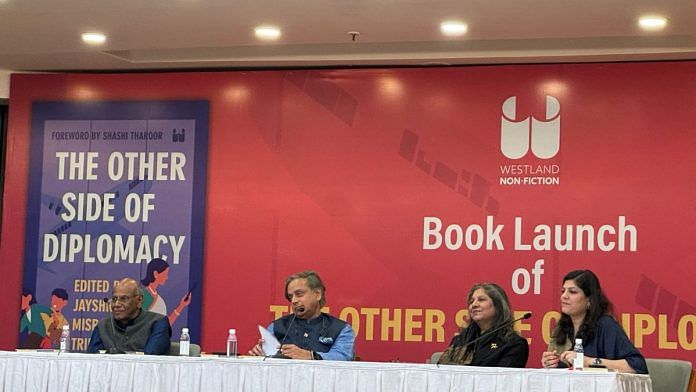New Delhi: It was an event of diplomats, but the buzz wasn’t about foreign policy. Instead, it was about those who navigate diplomacy from the sidelines—the spouses. The Kamala Devi Hall at IIC drew a crowd of young and old, eager to hear behind-the-scenes stories of a diplomat’s life.
At the heart of the event was The Other Side of Diplomacy, a book edited by Jayshree Misra Tripathi. A compendium of the lives of diplomatic spouses—mostly wives—the book explores their journeys, raising families in unfamiliar lands while adapting to ever-changing environments. The evening featured a powerhouse panel, including Ambassador Shyam Saran, President of IIC, MP Shashi Tharoor, and the book’s editor herself. Tripathi’s daughter and journalist Amrita Tripathi moderated the discussion.
“The Other Side of Diplomacy should have been titled The Better Half of Diplomacy,” said Ambassador Saran in his opening remarks.
Tharoor, who wrote the foreword for the book, admitted he was flattered by the invitation. “Because I have neither been a foreign service officer nor a foreign service spouse. But I have enjoyed the hospitality of a couple of the authors featured in these essays,” he quipped, drawing a round of applause from the audience.
Behind the glamour and glitz of the diplomacy world, the book of essays by 13 women including two daughters, and two men recounts historic, entertaining and intriguing episodes from their lives.
“As a diplomatic spouse, balancing family life is a common challenge. The most difficult part is moving with teenage children—having to uproot them from their friends and familiar surroundings, dragging them from one country to another,” said Tripathi, a poet and diplomatic spouse.
Also read: Is Qatar’s influence testing India’s diplomatic power? Delhi event decodes Doha’s power games
Step up to the plate or perish
Journalist Reshmi Ray Dasgupta sums up the life of a diplomat’s spouse in two stark choices: step up to the plate or perish. In one of the book’s chapters, she writes about her mother, Gayatri Ray’s brushes with new cultures and languages through her diplomat husband.
One such moment led to an unexpected kiss—while shopping for a cushion in Germany, Dasgupta’s mother inadvertently pronounced it as Küssen (the German word for kissing), prompting the shop assistant to plant a peck on her cheek.
In another incident, Dasgupta recalls how her mother had to travel by ship—since diplomatic families were barred from air travel—to Europe via South Africa in 1956, when the Suez Canal was closed due to the Second Arab-Israeli War.
“As she went ashore with friends in Cape Town to shop and post letters. A salesman said that he would only serve the lone white woman, who promptly replied that she would not care to be served by him, and they all walked out,” the chapter named ‘Beyond The Call Of Matrimony’ reads. It became, as Dasgupta puts it, her mother’s “Gandhi-ji at Pietermaritzburg” moment.
From then until apartheid ended 34 years later, Dasgupta’s mother resolutely boycotted all things South African.
Also read: Sanskrit to satellites, embassies in Delhi are using culture to show ties, get close to India
Gender disparity
The stark gender disparity in diplomacy was agreed upon both by the panel and the audience. This imbalance was evident in the book itself, with only two male contributors.
In his foreword, Tharoor acknowledged this. “It is indeed disappointing that the foreign service still remains a largely male bastion globally,” he wrote. He reiterated this at the event as well by citing the Women in Diplomacy Index 2022 data compiled by the Diplomatic Academy in the UAE.
“India ranked 26th out of 40 countries plus the EU, with only 16.9 per cent of ambassadorial positions held by women at the time,” Tharoor said. He added that in many ways, the book has shouldered the burden of representing Indian womanhood, as there simply weren’t enough women ambassadors to do so.
There was a moment of laughter when Amrita Tripathi found herself being micromanaged by her mother, Jayshree Misra Tripathi. The stage felt like a household scene, with a mother ushering her daughter—telling her who to pass the mic to and whom to call on for questions.
Amid this, Amrita turned to one of the authors in the audience and quipped, “What were your thoughts when this lady, who is already giving micromanaging directions here on stage, asked you to share your story?”
The audience erupted in laughter.
(Edited by Theres Sudeep)






